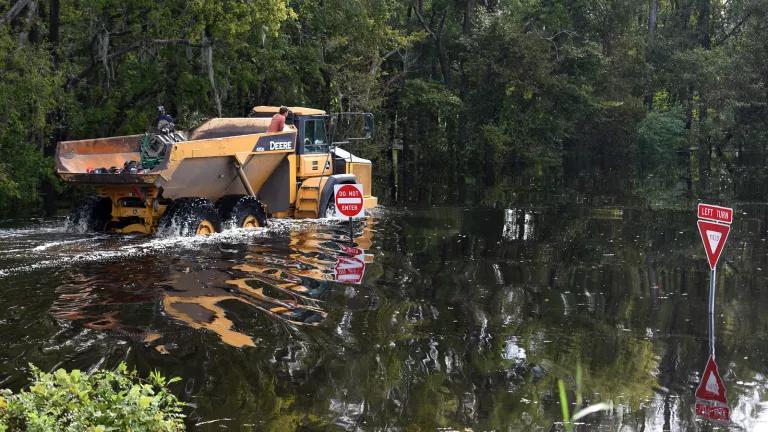
Our country’s electric grid is in a state of rapid transition. As the grid shifts towards clean energy sources like wind and solar and an increasing number of electrified vehicles and buildings, it also faces more frequent extreme weather events brought on by accelerating climate change. Most days, the grid can handle normal supply and demand. However, in extreme weather events, conditions can harm generation by way of frozen or overheated equipment while simultaneously increasing electricity demand for heating or air conditioning. In crisis-level events like heat waves and polar vortices, reliable air conditioning and heat can become matters of life and death.
Business as usual will not deliver the essential level of reliability we depend on. Without the ability to move large amounts of electricity from one region of the country to another, keeping the lights on during increasingly frequent severe weather events may not be possible. As Winter Storm Uri tragically demonstrated in Texas in 2021, lack of connections with other regions of the country can have disastrous consequences.
At any given time, we have abundant electricity (increasingly powered by renewable resources) available around the country. What we don’t have are the policies and practices needed to move power to make it available where it is needed, particularly in places where the alternative is higher-cost, higher-emitting fossil fuel-based electricity.
NRDC engaged GE Energy Consulting to perform a study examining the benefits of additional interregional transmission. The study found that increasing the amount of transmission capacity between regions would improve the grid’s reliability, provide more affordable electricity to consumers, and improve its resilience. Each of these benefits is discussed in more detail below.
More interregional lines would improve the grid’s reliability during extreme weather events
In the study, GE modeled two extreme weather events that resulted in high demand in both and reduced supply: a summer heatwave and a winter polar vortex. In the simulated heatwave (which was modeled after one in August 2018), demand increased by more than a third above the average for that time of year. In the simulated polar vortex (which was based on a February 2014 winter storm), demand increased by 40% and electricity supply was reduced by 15% as cold weather knocked generators offline (fossil gas is particularly vulnerable to very cold weather). The study then modeled two different scenarios: our existing system where interregional transmission is constrained, and a model scenario where there was sufficient interregional transmission capacity.
The results were staggering. The constrained heatwave scenario left hundreds of thousands of people without power, including 600,000 customers in New York City and 140,000 in Washington, DC, and led to costs totaling $875 million as a result of this loss of load. Similarly, a simulated polar vortex caused nearly 2 million customers across the East Coast to lose power and cost consumers $1 billion. In contrast, removing these interregional constraints completely eliminated blackouts in both the heatwave and polar vortex scenarios.
As extensive research has shown, extreme heat conditions can be deadly, particularly for older adults, young children, people with chronic illness, lower-income communities, communities of color, and people who work or exercise outdoors. The ability to better mitigate extreme heat with air conditioning powered by available clean electricity could save thousands of lives.
Increasing interregional transmission saves money
Increasing transmission capacity between regions also reduces costs to consumers. As regions are able to import and export electricity more freely, they can gain access to cheaper energy. As a result, overall generation capacity can be lower within the entire Eastern part of the United States (called the “Eastern Interconnect”) because regions are able to tap generation sources with lower costs in other regions than they would otherwise be able to source from within their own region. GE’s study showed exactly this: production costs (i.e., the costs to produce electricity) were $3-4 billion per year lower in the Eastern Interconnect in the unconstrained scenario than in the constrained scenario in 2035.
GE’s results are likely conservative, and perhaps significantly so. For example, GE’s financial projections include a natural gas price forecast that is cheaper than current natural gas prices, and are likely cheaper than projected future natural gas prices, meaning that consumer savings are likely higher. In addition, GE used average electricity flows between regions in its simulations, whereas these flows may actually be much larger during large summer or winter weather events, meaning that the benefits of interregional transmission are likely to be greater. GE also assumed that each region had adequate resources to meet normal electricity demand, but if individual regions can depend on external regions for imported power rather than building generation internally, cost savings may be significant. In sum, GE’s results are likely a floor and certainly not a ceiling—actual cost savings to consumers if interregional transmission becomes more prevalent will almost certainly be much higher.
Increasing interregional transmission may help overall grid resilience
More interregional transmission will go a long way toward providing reliable and affordable electricity but is not a complete panacea for all of the grid’s challenges. GE found that a grid without constraints on interregional transmission was only somewhat more stable—which refers to fluctuations in voltage which can lead to generators switching offline temporarily to protect from damage. However, the results improved if operators incorporated newer transmission technologies like HVDC, which is less vulnerable to voltage disturbances like lightning strikes, into their interregional transmission plans.
How do we get more interregional transmission? First, NRDC strongly urges FERC to reform the process for interregional planning, which is badly broken and has resulted in virtually no major interregional lines in the last decade. FERC issued a proposed rule on regional transmission planning in April 2022 which takes several promising steps, although we believe it could be even stronger. Another idea is to require different regions to have a certain amount of available transmission capacity between regions (i.e. a minimum transfer capacity requirement). Such a requirement could be designed in different ways, such as a minimum amount of available transmission capacity between regions, or as a percentage requirement of either total installed generation capacity or electricity demand in a region or multiple regions. Regardless of how the requirement is structured, regions would need to demonstrate firm transfer capacity to deliver and accommodate those resources, thus guaranteeing their ability to receive and deliver power from other regions.
We live in a world that is being impacted by climate change in real time. Extreme weather is likely to happen more often and be more intense. We need electric infrastructure that is ready for this. This report demonstrates that more interregional transmission planning can save money on electricity bills, ensure energy reliability, and even save people’s lives. It’s time to get to work building the 21st century grid we know we need. There’s no time to waste.
You can view the full study here: https://www.nrdc.org/sites/default/files/ge-nrdc-interregional-transmission-study-report-20221017.pdf



